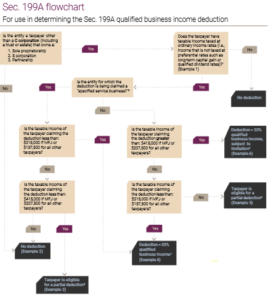 The TCJA, (Tax Cuts and Jobs Act) kicked into gear for better or for worse on January 1, 2018. Most folks and entities will be affected one way or another. This week we are talking about the changes for individuals. Keep in mind most of these changes are scheduled to go away after 2025 and things could quite possibly go back to the way they were. That is why they are called “temporary provisions”.
The TCJA, (Tax Cuts and Jobs Act) kicked into gear for better or for worse on January 1, 2018. Most folks and entities will be affected one way or another. This week we are talking about the changes for individuals. Keep in mind most of these changes are scheduled to go away after 2025 and things could quite possibly go back to the way they were. That is why they are called “temporary provisions”.
REINFORCING THE BASICS.
There is a pretty wordy blog so let’s just jump right into the TCJA, You, and Your 1040.
NOT QUITE THE SAME OLD SAME OLD.
Child Tax Credit. Doubles from one grand to two (through 2025). Twice as much buck for the bang. That’s practically another year of diapers or a couple of months of auto insurance for the newly added teen driver. What if you have a qualifying child (under age 17) but no tax liability? You can still get free money (refundable credit) and even more of it, $1,400 from $1,000. The phaseout limit more than doubled; it now starts at $200,000 (S) and $400,000 (MFJ). More families with (qualifying) children will WIN.
Estate and Gift Taxes. Lifetime exemptions have practically doubled (through 2025).
Gift taxes. For 2018 you can give away $15,000 (finally up from $14,000) each to family members.
Standard deductions. Increased (through 2025) though not quite doubled as you may have heard.
2018: $12,000 – Single; $18,000 – HOH; and, $24,000-MFJ.
2017: $ 6,350 – Single; $ 9,350 – HOH; and, $12,700-MFJ.
Tax rates and brackets. Most of the brackets are wider meaning there’s more $$$ taxed at lower rates.
| Rate
2017 |
Rate
2018 – 2025 |
Single
$ |
HOH
$ |
MFJ
$ |
MFS
$ |
| 10% |
10% |
9,525 |
13,600 |
19,050 |
9,025 |
| 15% |
12% |
38,700 |
51,800 |
77,400 |
38,700 |
| 25% |
22% |
82,500 |
82,500 |
165,000 |
82,500 |
| 28% |
24% |
157,500 |
157,500 |
315,000 |
157,500 |
| 33% |
32% |
200,000 |
200,000 |
400,000 |
200,000 |
| 35% |
35% |
500,000 |
500,000 |
600,000 |
300,000 |
| 39.6% |
37% |
>500,000 |
>500,000 |
>600,000 |
>300,000 |
How it works: If you are MFJ with taxable income of $161,543:
19,050 x 10% = $ 1,905
58,349 x 12% = $ 7,002
84,144 x 22% = $18,512
$161,543 $27,419 Tax liability in 2018.
Trust us on this, verify if you must. The 2017 tax liability was $31,863. A savings of $4,444 and 14%. That is definitely more money in the pocket. Keep in mind that taxable income is next affected by tax brackets making all of us winners.
It this MFJ couple had a $1,000 credit, the benefit would be $1,000 and the tax liability $26,419.
If this MFJ couple had a $1,000 in deductions, the benefit would be $220, and the tax liability $27,199.
IF YOU THINK YOU CAN DANCE…..WE MEAN ITEMIZE.
Charitable Contributions. You can still write off what you give unto others. Cash is up to 60% (increased from 50%) of your adjusted gross income and stock stays the same at 30%.
Home Equity Interest/Home Equity Line of Credit (HELOC)/2nd Mortgage. Is still an itemizable deduction, IF the loan was used for buying, building, or substantially improving the residence that secures the loan. These loan amounts are combined with mortgage loans and are collectively called Qualified Residence Loans.
Medical Expenses. For 2017 and 2018, expenses exceeding 7.5% of income are deductible. In 2019 this goes up to 10%.
Mortgage Interest. Interest on up to a million-dollar mortgage entered into prior to December 15, 2017 is grandfathered and still deductible (even if refinanced). If you buy a house after December 15, 2017 and through December 31, 2025 that cool million is lowered to $750,000 and includes any and all home equity loans and second mortgages.
State & Local Tax Deductions. In the good old days ALL property and state/local income taxes or sales taxes were deductible unless you were trapped in AMT. But now the deduction for these taxes is capped at $10,000. Whew, this was almost a goner! And no, it doesn’t double if you are married filing joint (MFJ). High tax states such as CA, NY, NJ, CT, and MD are not too happy. States look for loopholes too!
KEEPERS.
Adoption Credit. Nonrefundable tax credit for qualified adoption expenses paid to adopt an eligible child.
American Opportunity Tax Credit. For the first four years of higher education.
Amortizable Bond Premium. Is a 2 percenter that didn’t get axed.
Assistance – Adoption, Dependent Care, and Education. All remain.
Elderly OR Disabled Credit. This is a little-known credit that can bring in cash of between $3,750 and $,7500 but you have to be 65 or older OR retired on permanent and total disability. You must be collecting some taxable disability income and then of course meet defined income limits.
Earned Income Credit. This credit has been helping working people with low to moderate income for 45 years and probably isn’t going anywhere anytime soon.
Educator Expense Deduction. Remains the same at $250 above the line. It almost made it to $500, maybe next time.
Gambling Losses. Casual gamblers can still deduct losses up to amount of winnings as an itemized deduction on Schedule A. Professional gamblers can still deduct losses AND related expenses up to amount of winnings on Schedule C. Examples of related expenses are admission/entry fees, ATM fees, handicapping data, subscriptions, telephone and internet, and travel. See ya at the Hard Rock!
Plug-in Electric Vehicles Credit. Those cars, Friday night, downtown, you get all excited when you see a parking space and there’s a big old outlet and no car.
Qualified Tuition. Still an above the line deduction.
Sale of Primary Residence. Gain is still excluded, $250,000 Single, $500,000 MFJ if you have owned and lived in the house 2 of the past 5 years.
Saver’s Credit. Only 25% of households with income less than $50,000 are aware of this credit. This non-refundable credit is sort of like Uncle Sam matching your retirement contributions.
Student Loan Interest. Remains the same at $2,500 above the line.
GONERS.
Alimony. Beginning in 2019 alimony has nothing to do with income tax.
Casualty Losses. Deductions for casualty and theft losses are no longer deductible (through 2025) unless in a Federally Declared Disaster Area.
Exemptions. Bye-bye personal and dependent exemptions (through 2025). For yourself, the other half, the kids and other dependents. These were worth $4,050 a pop in 2017. Figure what would have been an increase of 50 bucks each year after that. Keep in mind that taxable income is also affected by dependents. So, the more dependents you have through 2025 the less the increased standard deduction benefits you.
Foreign Real Property Tax. Property taxes paid in foreign countries (through 2025) are no longer deductible.
Living expense deduction for members of Congress. Since 1953 Congress has been writing off living expenses while outside their district/state. Three grand a year!
Moving Expenses. Moving expenses no longer deductible; unless, you are active duty military.
Recharacterizing ROTH conversions. If you previously converted a pretax traditional IRA into a ROTH IRA, you are stuck with it.
Shared Responsibility Payment (SRP). Good bye and good riddance in 2019 to this tax penalty for not having health coverage or a qualified exemption under the Affordable Care Act, known affectionately and not so affectionately as Obamacare. In 2017, the punishment was the greater of $695 per person or 2.5% of household income. This year the IRS rejected 2017 returns that did not include evidence of coverage or exemption, or the SRP. They may do so again for 2018 returns, so be sure to check the box this year or pay the piper.
The Two Percenters. These are the Miscellaneous Itemized Deductions, a pretty long list of personal expenses that are no longer deductible (though 2025).
Unreimbursed employee expenses. This is out-of-pocket money spent on ordinary and necessary stuff to do your work. Say goodbye to:
Work-related travel, transportation, and meal expenses;
Work-related education;
Job search expenses for new job in same profession/occupation;
Union dues;
Dues to professional societies;
Subscriptions to professional and trade publications;
Supplies and tools;
Work clothes and uniforms;
Home office expenses;
Depreciation on employer-required computers and cell phones;
Business liability insurance premiums; and,
Legal fees.
Hobby expenses. Once again Congress frowns upon fun. Like gambling losses, you used to be able to deduct hobby expenses up to the amount of hobby income. Not any more but wait for it… you still have to report hobby income. If you actually sell your stuff to people, you can deduct cost of goods sold.
Investment expenses. Fees for personal investing are not deductible. This would be all your investment advisory, management fees, and trustee fees as well as fees for investment-related tax and legal advice. Also, all expenses incurred to manage investments such as rents, administrative help, computers and electronics, and home office deduction. If you get a K-1, the investment expense is no longer a miscellaneous itemized deduction.
Other. No more writing off the safety deposit box, the amount we charge to expertly prepare your tax return, or any monies you spend to do battle with the IRS.
NEWBIES.
529 Savings Plans. Qualified education expenses now include primary and secondary school expenses.
Non-child Dependent Credit. Brand spanking new, never before seen $500 not refundable credit (through 2025): This credit provides cash for your elderly or disabled dependents and children over 17. Before you even hope – you can’t claim the credit for yourself or your spouse. There are a few rules: 1. You must provide more than 50% of their support, 2. They must have less than $4,050 in income, and 3. They must be closely related or have lived with you all year.
WHAT ELSE SHOULD I KNOW?
⇒ If you don’t want to use up the annual $15,000 gift tax exclusion, remember that generally these gifts don’t count when given to your spouse or a qualified charitable group or when paid straight to a health care provider or educational institution.
⇒ If you do have unreimbursed employee expenses we suggest properly documenting these expenses and asking your boss to pay you back. The reimbursement would be tax free to you.
⇒ If you prepaid 2018 property taxes in 2017, it more than likely didn’t count. The IRS clarified that in order for property taxes to be deducted they had to have been assessed.
If you are wondering how all this new tax stuff affects you, reach out to McAtee and Associates for answers and guidance. #CallCarolFirst! Carol would enjoy doing some tax planning and advising with you.
info@accpas.com OR 727-327-1999.
Check back here next week when we tackle the TCJA impact on entities and business taxes. And be sure to like us on FaceBook and follow us on Twitter; for whatever it is we’ll be posting.


 Frances Cleveland who created quite the techy tree in 1895 when she hung electric lights on the White House tree. Heck, Grover even shot his own duck for Christmas Dinner.
Frances Cleveland who created quite the techy tree in 1895 when she hung electric lights on the White House tree. Heck, Grover even shot his own duck for Christmas Dinner. Coolidge. There were concerts and crowds and celebrations. This was the beginning of an American tradition now nearly a century old.
Coolidge. There were concerts and crowds and celebrations. This was the beginning of an American tradition now nearly a century old.
 Brand-new tax credit courtesy of the Tax Cuts and Jobs Act (TCJA). Employer Credit for Paid Family and Medical Leave. But first.
Brand-new tax credit courtesy of the Tax Cuts and Jobs Act (TCJA). Employer Credit for Paid Family and Medical Leave. But first. are met. Those requirements being taxpayers self-report their income annually and submit income tax payments.
are met. Those requirements being taxpayers self-report their income annually and submit income tax payments. where do they put it all?
where do they put it all? Business 800-829-4933
Business 800-829-4933
 Or a prize or award recognizing past (religious, charitable, artistic, scientific, educational, literary or civic) accomplishments. Or when you win stuff without betting, for example, in a sweepstakes or a raffle. If it’s stuff; the amount 1099’d is the fair market value of the item. If an employee dies and the last owed amounts/paychecks are paid after the year of death, the amount goes here. Most punitive damages and damages for nonphysical injuries or sickness are taxable and reportable in box 3. Here’s a fun one: medical research payments, when you participate in clinical trials for everything from dream studies to ulcers.
Or a prize or award recognizing past (religious, charitable, artistic, scientific, educational, literary or civic) accomplishments. Or when you win stuff without betting, for example, in a sweepstakes or a raffle. If it’s stuff; the amount 1099’d is the fair market value of the item. If an employee dies and the last owed amounts/paychecks are paid after the year of death, the amount goes here. Most punitive damages and damages for nonphysical injuries or sickness are taxable and reportable in box 3. Here’s a fun one: medical research payments, when you participate in clinical trials for everything from dream studies to ulcers.





 REINFORCING THE BASICS.
REINFORCING THE BASICS.
 The TCJA, (Tax Cuts and Jobs Act) kicked into gear for better or for worse on January 1, 2018. Most folks and entities will be affected one way or another. This week we are talking about the changes for individuals. Keep in mind most of these changes are scheduled to go away after 2025 and things could quite possibly go back to the way they were. That is why they are called “temporary provisions”.
The TCJA, (Tax Cuts and Jobs Act) kicked into gear for better or for worse on January 1, 2018. Most folks and entities will be affected one way or another. This week we are talking about the changes for individuals. Keep in mind most of these changes are scheduled to go away after 2025 and things could quite possibly go back to the way they were. That is why they are called “temporary provisions”.